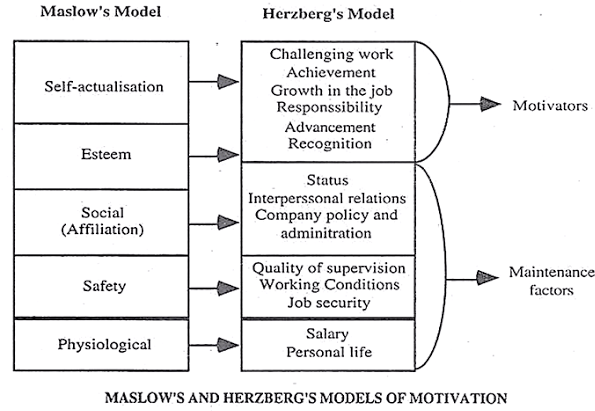Comparison of Maslow and Herzberg’s Theory of Motivation shows the similarities and differences between the hierarchy of needs and two-factor theory. Maslow and Herzberg provided the most popular human motivation theories used in the workforce.
Maslow’s hierarchy of needs and Herzberg’s two-factor theory are compared and we try to find out what makes them similar and also different.
Similarities of Maslow and Herzberg Theory of Motivation
There is a great similarity between Maslow’s and Herzberg’s models of motivation.
A close examination of Herzberg’s model indicates that for those employees who have achieved a level of social and economic progress in the society, higher-level needs of Maslow’s model (esteem and self-actualization) are the primary motivators.
However; they still must satisfy the lower level needs for the maintenance of the current state.
So we can say that money might still be a chief motivator for most of the operative employees and also for some low paid managerial people.
Herzberg’s model distinguishes the two groups of factors, namely, motivational and maintenance, and points out that the motivational factors are often derived from the job itself.
Most of the maintenance factors come under comparatively lower-order needs and motivational factors are somewhat equivalent to higher-order needs.
Both models assume that specific needs energize behavior.
Although there are marked similarities in the two models, many differences exist which are shown in the following way:
Differences Between Maslow and Herzberg Theory of Motivation;

| Why is Maslow’s and Herzberg’s Theory of Motivation different? | ||
|---|---|---|
| Issue | Maslow’s Model | Herzberg’s Model |
| Order of needs | The hierarchical arrangement of needs. | No such hierarchical arrangement. |
| Emphasis | Descriptive. | Prescriptive |
| The essence of the theory | Unsatisfied needs energize behavior; this behavior causes performance. | Gratified needs cause performance. |
| Motivator | Any need can be a motivator if it is relatively unsatisfied. | Only higher-order needs serve as motivators. |
| Applicability | Takes a general view of the motivational problems of all workers. | Takes a micro-view and deals with work-oriented motivational problems of professional workers |
| Factors | The existence of some factors creates a positive attitude and their non-existence creates a negative attitude. | The positive and negative factors are completely different. |
Conclusion
The main difference between them is that; the basis of Maslow’s theory is human needs and their satisfaction. On the other hand, Herzberg’s theory relies on reward and recognition.